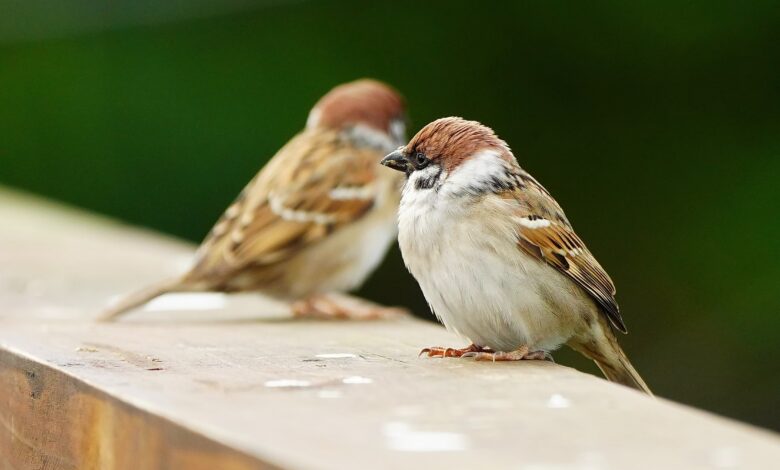Missing the Choral Chirping

 A little bird, with plumage brown,
A little bird, with plumage brown,
Beside my window flutters down,
A moment chirps its little strain,
Ten taps upon my window–pane,
And chirps again, and hops along,
To call my notice to its song;
But I work on, nor heed its lay,
Till, in neglect, it flies away.
The above lines from the poem ‘The Sparrow’ by the first African American poet Paul Laurence Dunbar (1872-1906) has remained with me since my childhood. Giving these spunky little birds broken rice grains to feed on, to watching them wait impatiently for their food, as grandma and mother would clean grain in the open veranda – the sparrows were a part of our lives back in the hills.
They are still there when we visit our home and seem to recognise us. From sitting on garden fences to briskly making their way inside the kitchens, to joining in a choir of chirping on tin roofs, they seem to be in some or the other conversation with us.
But ever since this friendly companion of ours is missing from the metropolitan cities, the poem seems to hold more relevance as the poet observes that this “Bird of peace and hope and love” has left us, since, “We in traffic’s rush and din/Too deep engaged to let them in/With deadened heart and sense plod on/Nor know our loss till they are gone”.
The sparrows have disappeared so quietly that no one has noticed them go. Either that or in the din of city life, people have been too busy to even forget their choral chirping, let alone miss their presence. The house sparrow (Passer domesticus) is no longer what it used to be — our ‘common’ friend.
According to scientists, sparrows thrived around human beings and where grain was abundant. Lack of nesting sites in modern concrete buildings, disappearing kitchen gardens and general apathy of humans towards this little but attractive bird have deprived them of their general habitat.
As we remembered this ‘common’ household member on ‘World Sparrow Day’ on March 20, a result of a vigorous campaign by scientist-conservationist Mohammad Dilawar, founder of ‘Nature Forever’, we also need to be serious as this little bird is gradually edging towards extinction and is listed in the Red List of the endangered species of the International Union for Conservation of Nature (IUCN), as well as of the Royal Society for Protection of Birds (RSPB), United Kingdom.
There is a sharp decline in many places in India such as Punjab, Haryana, West Bengal, Kerala, Gujarat, Rajasthan, etc. However, a ray of hope has emerged with the “State of India’s Birds 2000” report, which suggests that the population of House Sparrow has been fairly stable during the past 25 years.
The report is based on 10 million observations contributed by over 15,500 birdwatchers since 2,000, to an online portal called eBird. It suggests that the population of House Sparrow has been fairly stable during the past 25 years.
Further, in a report published by ‘Down to Earth’, titled Where have all the Sparrows gone?, the author V S Vijayan asserts the need for understanding the gravity of our ‘common birds’ that are at grave risk.
He points: “At the beginning of the 19th century, few would have thought that the passenger pigeon would become extinct one day”.
But it did happen. From an estimated figure of 5-10 billion in the first half of the 19th century, it took few more decades before all the birds were gone, all because of being mercilessly hunted down for meat.
The history of our house sparrow is also fascinating. The ancient Romans introduced the house sparrow to Europe from North Africa and Eurasia. Then human exploration and migration took the bird to many other parts of the globe, including North and South America, South Africa, Australia and New Zealand.
Scientific studies also point to the astonishing fact that wherever there is a human population, the sparrows followed them there. Fossil evidence from a cave in Bethlehem dating back 4,00,000 years suggest that the house sparrow shared its space with early humans. Also, according to a 2018 Royal Society of London report, the bond between humans and sparrows goes back 11,000 years.
Conservationists attribute the decline in the population of house sparrows to the unfriendly architecture of our homes, chemical fertilisers in our crops, noise pollution that disturbs acoustic ecology and noxious exhaust fumes from vehicles.
A report further attributed the depleting population of sparrows to the increased use of packed food, insecticides in farming and changing lifestyles, resulting in an inadequate availability of food for the birds. They also feel that unlike pigeons that can make nests on ledges, sparrows need cavities to build their nests and since the new defective architectural matchbox style buildings don’t have cavities, sparrows are left homeless.
Ornithologists suggest that people should provide some places in their homes for their shelter, where sparrows can easily make their own nest and lay their eggs.
It is far better to hear the chirping, rather than the numbed silence.




